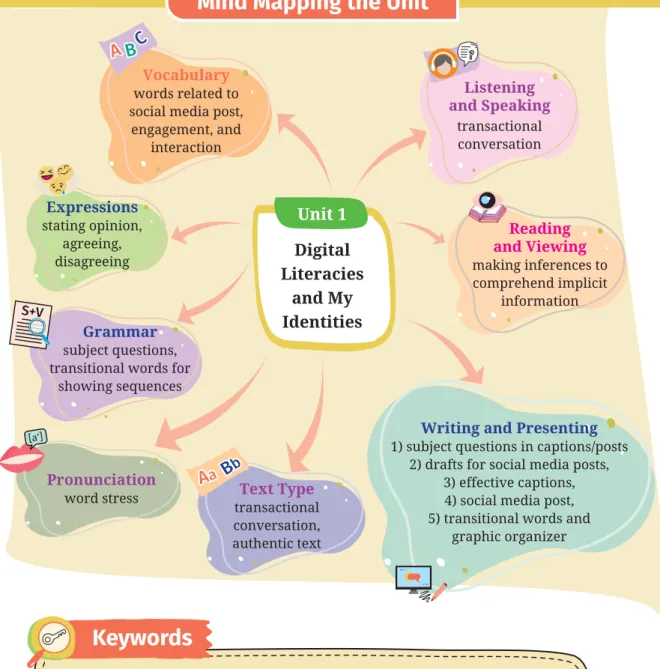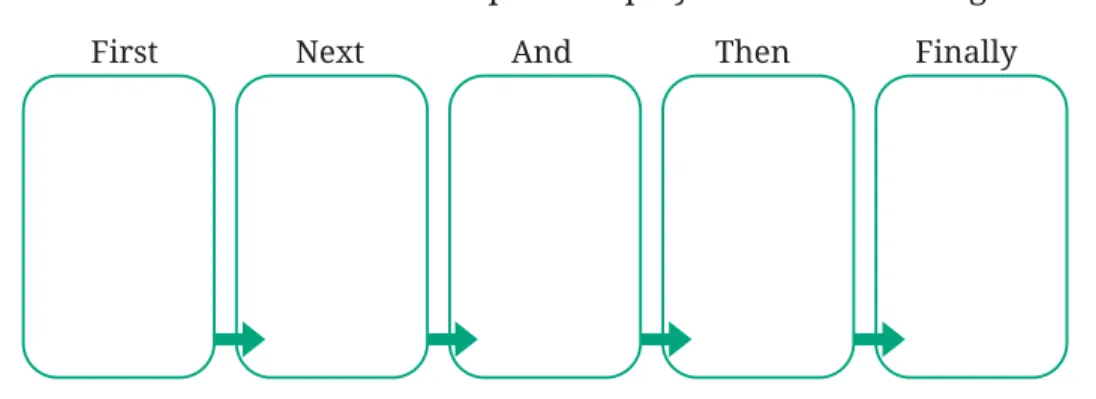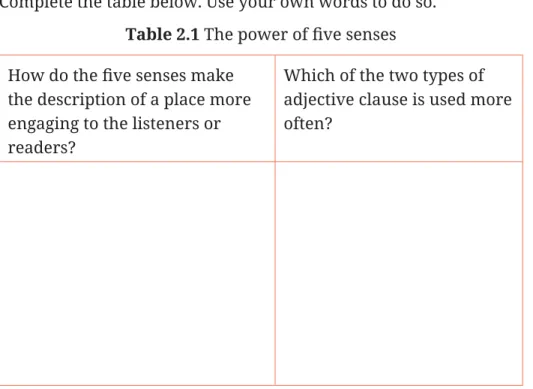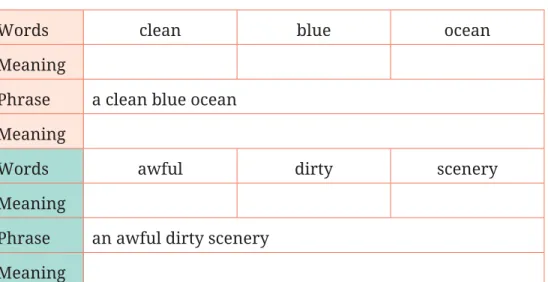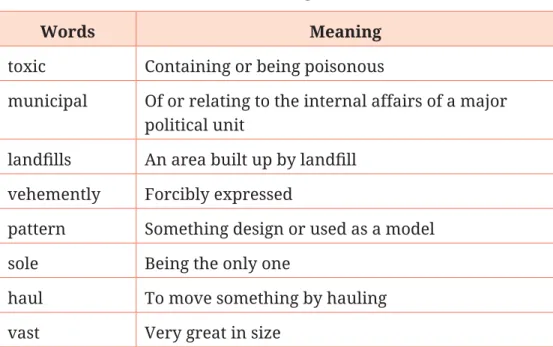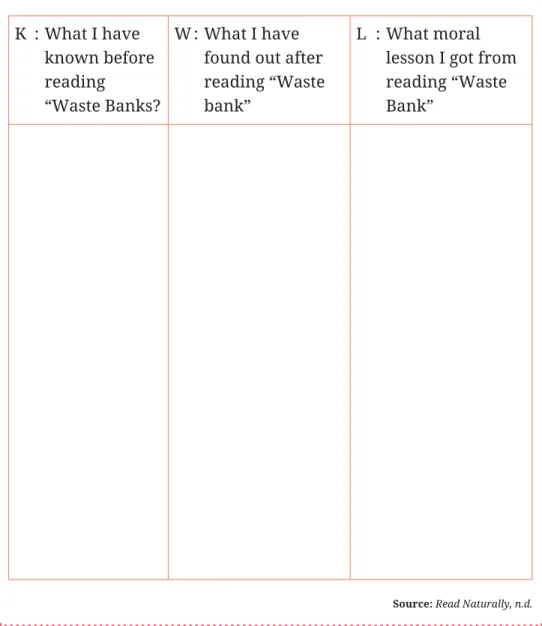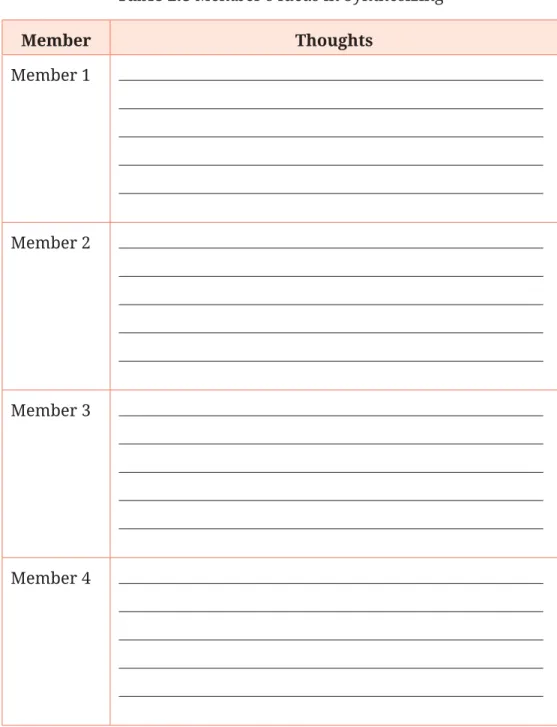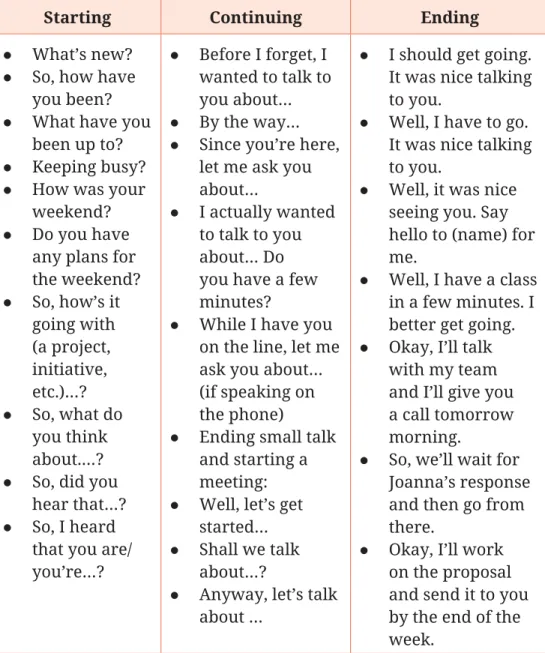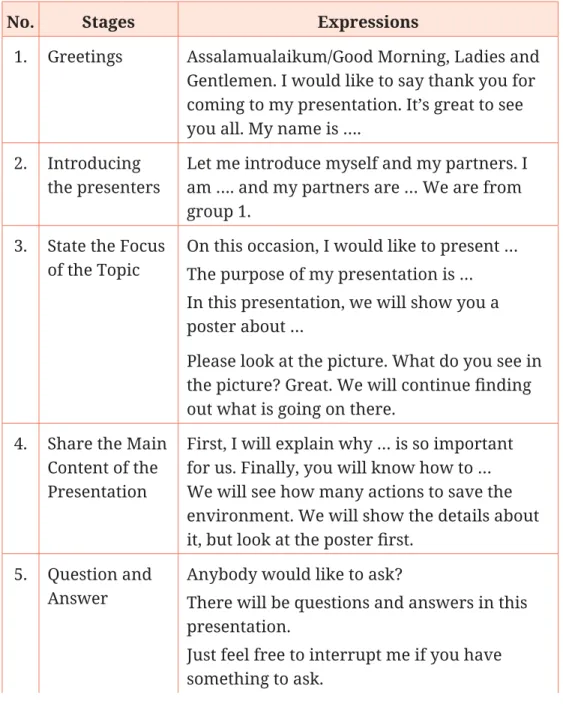KEMENTERIAN PENDIDIKAN, KEBUDAYAAN, RISET, DAN TEKNOLOGI 2022
BAHASA INGGRIS BAHASA INGGRIS
English for Change
English for Change
Hak Cipta pada Kementerian Pendidikan, Kebudayaan, Riset, dan Teknologi Republik Indonesia
Dilindungi Undang-Undang
Penafian: Buku ini disiapkan oleh Pemerintah dalam rangka pemenuhan kebutuhan buku pendidikan yang bermutu, murah, dan merata sesuai dengan amanat dalam UU No. 3 Tahun 2017. Buku ini disusun dan ditelaah oleh berbagai pihak di bawah koordinasi Kementerian Pendidikan, Kebudayaan, Riset, dan Teknologi. Buku ini merupakan dokumen hidup yang senantiasa diperbaiki, diperbarui, dan dimutakhirkan sesuai dengan dinamika kebutuhan dan perubahan zaman. Masukan dari berbagai kalangan yang dialamatkan kepada penulis atau melalui alamat surel buku@kemdikbud.go.id diharapkan dapat meningkatkan kualitas buku ini.
Bahasa Inggris: English for Change untuk SMA/MA Kelas XI Penulis
Puji Astuti
Aria Septi Anggaira Atti Herawati Yeyet Nurhayati Dadan
Dayang Suriani Penelaah
Eva Tuckyta Sari Sujatna Lulu Laela Amalia Penyelia/Penyelaras Supriyatno
Lenny Puspita Ekawaty Awaliyah Nurina Utami Umri Nening Daryati
Kontributor Hargo Suprapto Ina Fajrina Ilustrator Aria Nindita Editor
Kristine Ann Manreal Capa Desainer
Imee Amiatun Penerbit
Kementerian Pendidikan, Kebudayaan, Riset, dan Teknologi Dikeluarkan oleh:
Pusat Perbukuan
Kompleks Kemdikbudristek Jalan RS. Fatmawati, Cipete, Jakarta Selatan https://buku.kemdikbud.go.id
Cetakan Pertama, 2022
ISBN 978-602-244-896-9 (no.jil.lengkap) ISBN 978-602-427-944-8 (jil.2)
Isi buku ini menggunakan huruf Noto Serif 11/16pt., Steve Matteson xxii, 266 hlm.: 17,6 × 25 cm.
Pusat Perbukuan; Badan Standar, Kurikulum, dan Asesmen Pendidikan;
Kementerian Pendidikan, Kebudayaan, Riset, dan Teknologi memiliki tugas dan fungsi mengembangkan buku pendidikan pada satuan Pendidikan Anak Usia Dini, Pendidikan Dasar, dan Pendidikan Menengah, termasuk Pendidikan Khusus. Buku yang dikembangkan saat ini mengacu pada Kurikulum Merdeka. Kurikulum ini memberikan keleluasaan bagi satuan/program pendidikan dalam mengimplementasikan kurikulum dengan prinsip diversiikasi sesuai dengan kondisi satuan pendidikan, potensi daerah, dan peserta didik.
Pemerintah dalam hal ini Pusat Perbukuan mendukung implementasi Kurikulum Merdeka di satuan pendidikan dengan mengembangkan buku siswa dan buku panduan guru sebagai buku teks utama. Buku ini dapat menjadi salah satu referensi atau inspirasi sumber belajar yang dapat dimodiikasi, dijadikan contoh, atau rujukan dalam merancang dan mengembangkan pembelajaran sesuai karakteristik, potensi, dan kebutuhan peserta didik.
Adapun acuan penyusunan buku teks utama adalah Pedoman Penerapan Kurikulum dalam rangka Pemulihan Pembelajaran yang ditetapkan melalui Keputusan Menteri Pendidikan, Kebudayaan, Riset, dan Teknologi No. 262/M/2022 Tentang Perubahan atas Keputusan Mendikbudristek No. 56/M/2022 Tentang Pedoman Penerapan Kurikulum dalam rangka Pemulihan Pembelajaran, serta Keputusan Kepala Badan Standar, Kurikulum, dan Asesmen Pendidikan Nomor 033/H/KR/2022 tentang Perubahan Atas Keputusan Kepala Badan Standar, Kurikulum, dan Asesmen Pendidikan Kementerian Pendidikan, Kebudayaan, Riset, dan Teknologi Nomor 008/H/KR/2022 tentang Capaian Pembelajaran pada Pendidikan Anak Usia Dini, Jenjang Pendidikan Dasar, dan Jenjang Pendidikan Menengah pada Kurikulum Merdeka.
Kata Pengantar
Sebagai dokumen hidup, buku ini tentu dapat diperbaiki dan disesuaikan dengan kebutuhan dan perkembangan keilmuan dan teknologi. Oleh karena itu, saran dan masukan dari para guru, peserta didik, orang tua, dan masyarakat sangat dibutuhkan untuk pengembangan buku ini di masa yang akan datang. Pada kesempatan ini, Pusat Perbukuan menyampaikan terima kasih kepada semua pihak yang telah terlibat dalam penyusunan buku ini, mulai dari penulis, penelaah, editor, ilustrator, desainer, dan kontributor terkait lainnya.
Semoga buku ini dapat bermanfaat khususnya bagi peserta didik dan guru dalam meningkatkan mutu pembelajaran.
Jakarta, Desember 2022 Kepala Pusat,
Supriyatno
NIP 196804051988121001
Preface
This book is dedicated to you, English learners in Grade XI. We name the book, English for Change, for two reasons. First, the goal of your learning is improving your communicative competencies in English.
Furthermore, we believe in the idea that “when there is learning, there is change and becoming” (Dewey 1920, 111). In learning a new language, you change: from less to more competent users of the language, for example. By engaging yourselves with the learning materials and activities in the book, you gradually attain the competencies, which allow you to experience a change in your life now and in the future.
Second, the idea of change experienced in the process and as a result of learning is in line with the philosophy of Merdeka Belajar and the goal of Kurikulum Merdeka. The word merdeka here was generated from Ki Hajar Dewantara’s philosophy of human emancipation through education. It underlines how education should enable learners to be emancipated individuals: capable of living independently, standing tall on their strength, and managing their life in an organized manner without being ordered by any other party. English language learning will contribute to your gradual change of becoming emancipated individuals.
The book is divided into ive units with different themes, including digital safety (Unit 1), environmental awareness (Unit 2 and 4), nutrition and wellness (Unit 3), and inancial literacy (Unit 5). They will enrich your repertoire and equip you to become more emancipated individuals and active members of your society. Each unit has six lessons following the six language skills mandated by the curriculum: listening, speaking, reading, viewing, writing, and presenting. Each lesson has its learning objective(s); they work together to attain the target competencies.
Overall, English learning in Grade XI is targeted at helping you achieve the B1 level of the Common European Framework of Reference for Languages: Learning, Teaching, Assessment (CEFR).
With the goal of your English learning in mind, we designed your learning activities following a Genre-Based Approach (GBA). Speciically, the activities are framed within ive stages, namely: Building Knowledge of the Field (BKoF), Modeling of Text (MoT), Joint Construction of Text (JCoT), Independent Construction of Text (ICoT), and Linking Related Texts (LRTs). We wrote the stages’ names in each lesson to promote your metalanguage and self-regulated learning. With the stages in mind, you know what to expect, perform accordingly, and plan for the next. Note that self-regulated learning is one of the dimensions of Proil Pelajar Pancasila.
Through English for Change, you experience active learning, speciically cooperative learning (CL). The 17 CL techniques in the book will help you to attain the competencies and another dimension of Proil Pelajar Pancasila namely gotong royong (mutual cooperation).
You will be accountable for your learning and perform gotong royong to optimize your peers’ learning. Through GBA and CL, you gradually gain 21 Century Skills, including critical thinking, creativity, collaboration, communication, leadership, productivity, and social skills.
Located between MoT and JCoT, we present two featured activities:
1) What Have You Learned So Far? and 2) A Mid-Lesson Relection. We place the two activities there to prepare yourselves before JCoT and perform individually/in pairs at ICoT. The irst featured activity helps you recall the newly learned materials. The second helps you to see the relevance of the materials and life outside school; you are also engaged in issues related to the themes and develop in yourselves: Pancasila values.
Finally, we would like to acknowledge Pusbuk for allowing us to experience a collaborative writing journey and complete this book. Our acknowledgment also goes to our universities/schools for their support during our writing process. We were grateful to have great reviewers whose feedback made this book stronger and to have worked with a devoted production team (editor, illustrator, and designer). We dedicate English for Change to you, English learners in Indonesia. We wish that you gradually become emancipated learners as you are using the book.
The Writers
Table of Content
Kata Pengantar ... iii
Preface ... v
List of Picture ... ix
List of Table ... xiii
What’s in Each Unit? ... xiv
Unit 1 Digital Literacies and My Identities ... 1
Mind Mapping the Unit ... 2
Listening ... 3
Speaking ... 10
Reading ... 15
Viewing... 24
Writing ... 31
Presenting ... 39
An End-of-Unit Relection ... 44
Unit 2 Love Your Environment ... 45
Mind Mapping the Unit ... 46
Listening ... 47
Speaking ... 56
Reading ... 63
Viewing... 73
Writing ... 85
Presenting ... 91
An End-of-Unit Relection ... 96
Unit 3 Healthy Life for a Healthy Future ... 97
Mind Mapping the Unit ... 98
Speaking ... 105
Reading ... 111
Viewing... 121
Writing ... 126
Presenting ... 131
An End-of-Unit Relection ... 136
Unit 4 Indonesian Environmental Figures ... 137
Mind Mapping the Unit ... 138
Listening ... 139
Speaking ... 145
Reading ... 151
Viewing... 160
Writing ... 167
Presenting ... 174
An End-of-Unit Relection ... 180
Unit 5 Personal Money Management ... 181
Mind Mapping the Unit ... 182
Listening ... 183
Speaking ... 189
Reading ... 200
Viewing... 208
Writing ... 217
Presenting ... 223
An End-of-Unit Relection ... 228
Prosedur Cooperative Learning (CL) ... 230
Glossary ... 236
References ... 241
Index ... 250
Proil Pelaku Perbukuan ... 254
List of Picture
Picture 1.1 Social interaction in daily life ... 3
Picture 1.2 Kalis Mardiasih writer, storyteller, editor, and activist 9 Picture 1.3 Joshua Irwandi photographer and inalist of Pulitzer Prize ... 9
Picture 1.4 Students’ activity in their learning ... 10
Picture 1.5 Figuring out the purposes of a social media post ... 15
Picture 1.6 Maudy Ayunda, singer, actor, and educator ... 16
Picture 1.7 Greysia Polii, badminton player ... 20
Picture 1.8 Aan Mansyur, writer ... 22
Picture 1.9 A catchphrase about reading ... 25
Picture 1.10 Greta Thunberg, environmental activist ... 31
Picture 1.11 Paola (Paolita) Merrill, artist ... 32
Picture 1.12 Terasering of Indonesia ... 36
Picture 1.13 Name tent ... 37
Picture 1.14 Drafting for a social media post ... 39
Picture 2.1 Organized and unorganized waste ... 47
Picture 2.2 Piles of waste in urban area ... 56
Picture 2.3 Piles of waste in mountain area ... 56
Picture 2.4 Piles of waste in beach area ... 56
Picture 2.5 Piles of waste in the house ... 56
Picture 2.6 Piles of waste in industrial area ... 56
Picture 2.7 Unorganized rubbish bin at school ... 62
Picture 2.8 People are queuing at a waste bank ... 62
Picture 2.9 A woman is planting lowers in the garden ... 62
Picture 2.10 Solid waste management ... 64
Picture 2.11 Different types of waste ... 65
Picture 2.12 Students are discussing about descriptive text ... 67
Picture 2.13 Plastic waste in the 50’s ... 70
Picture 2.15 Queuing at the waste bank ... 74
Picture 2.16 Weighting plastic waste ... 74
Picture 2.17 Planning the future ... 75
Picture 2.18 Sorting out waste ... 75
Picture 2.19 Compiling sorted waste ... 77
Picture 2.20 Polluted beach ... 83
Picture 2.21 Different punctuation, different meaning ... 89
Picture 2.22 Giving a presentation ... 91
Picture 3.1 Eating junk food ... 99
Picture 3.2 Discussion at school ... 100
Picture 3.3 Discussion in the classroom ... 102
Picture 3.4 Screenshot of the video “The Debate between cooked versus Raw Food” ... 104
Picture 3.5 Cycling ... 109
Picture 3.6 Wise word about healthy life ... 111
Picture 3.7 A family is jogging. ... 112
Picture 3.8 Doctor and patient ... 116
Picture 3.9 The Importance of consuming fruit ... 122
Picture 3.10 Fruit habit consumption ... 122
Picture 3.11 Local fruits ... 124
Picture 3.12 Common fruits ... 125
Picture 3.13 Screenshot of the video Health Hazards of Junk Food – The Doctors ... 126
Picture 3.14 Graphic organizer about healthy life ... 129
Picture 3.15 Gardening ... 130
Picture 3.16 Speech Performance... 131
Picture 4.1 Watching TV ... 139
Picture 4.2 The students are watching video from a cell phone 141 Picture 4.3 Aeshnina Azzahra ... 142
Picture 4.4 Pak Sadiman ... 146
Picture 4.5 In the classroom ... 151
Picture 4.6 Laetania Belai Djandam ... 154
Picture 4.7 Salsabila Khairunnisa ... 157
Picture 4.8 Aeshnina Azzahra ... 158
Picture 4.9 Tasya Kamila ... 159
Picture 4.10 A Granny plants some trees ... 161
Picture 4.11 WH Question Thinking cloud ... 164
Picture 4.12 Five ways to go green ... 165
Picture 4.13 Isabel Wijsen (left) & Melati Wijsen (right) ... 167
Picture 4.14 Young environmental activists ... 167
Picture 4.15 Swietenia Puspa Lestari ... 170
Picture 4.16 Young environmentalists and their action ... 172
Picture 4.18 Farwiza Farhan ... 172
Picture 5.1 Traditional methods of saving ... 183
Picture 5.2 100 clothes are sold/day ... 189
Picture 5.3 50 clothes are sold/day ... 189
Picture 5.4 Cash for payment ... 190
Picture 5.5 Credit card for payment ... 190
Picture 5.6 Rp60.000,- ... 190
Picture 5.7 Rp200.000,- ... 190
Picture 5.8 Shopping at traditional market ... 190
Picture 5.9 Shopping at the mall ... 190
Picture 5.10 Crowds of buyers... 190
Picture 5.11 A few buyers ... 190
Picture 5.12 Shopping online ... 197
Picture 5.15 Graduation Ceremony ... 197
Picture 5.13 Shopping at a mall ... 197
Picture 5.14 Shopping at a retail store ... 197
Picture 5.16 Planning for a holiday ... 197
Picture 5.17 Future investment ... 197
Picture 5.18 Prices for painting ... 197
Picture 5.19 House for sale ... 197
Picture 5.20 Land for sale ... 197
Picture 5.21 Prambanan Temple ... 198
Picture 5.22 Mendut Temple ... 198
Picture 5.23 Borobudur Temple ... 198
Picture 5.24 Old-styled telephone ... 198
Picture 5.25 Old-styled electric lamp ... 198
Picture 5.26 Old-styled car ... 198
Picture 5.27 Listening using earphone ... 198
Picture 5.28 Direct Communication ... 198
Picture 5.29 Communication through letter ... 198
Picture 5.30 Comparison of saving for shopping and for going on a vacation ... 199
Picture 5.31 Comparison of online shopping and oline shopping 199 Picture 5.32 Savings book and ATM card ... 200
Picture 5.33 Entering an ATM booth ... 205
Picture 5.34 Banking transaction ... 208
Picture 5.35 ATM transaction ... 208
Picture 5.36 Saving receipt ... 208
Picture 5.37 ATM receipt ... 208
Picture 5.38 Graphic organizer on personal money management 209 Picture 5.39 10 ways to save money in high school ... 211
Picture 5.40 Differences between traditional and modern banking ... 214
Picture 5.41 Good habit of saving ... 218
Picture 5.42 Ways to save water-an analogy of saving money ... 218
Picture 5.43 Process of online shopping ... 221
Picture 5.44 Taking an online transportation ... 222
Picture 5.45 Mind map on a good presentation ... 224
List of Table
Table 2.1 The power of ive senses ... 53
Table 2.2 Adjective phrases ... 57
Table 2.3 Meaning of adjective phrases ... 57
Table 2.4 Word order in adjective phrases ... 59
Table 2.5 Parts of speech ... 66
Table 2.6 Meaning of Words ... 76
Table 2.7 K-W-L table ... 80
Table 2.8 Member’s Ideas in Synthesizing ... 82
Table 2.9 Explanation of punctuation ... 86
Table 3.1 Expressions for giving and defending opinions ... 101
Table 3.2 The structure of the analytical exposition text. ... 114
Table 4.1 Expressions for starting, continuing, and ending a transactional conversation ... 140
Table 4.2 Guidelines to Have a Powerful Presentation ... 176
Table 5.1 The /-st/ sound ... 191
Table 5.2 Internet vs Traditional Banking ... 215
Table 5.3 Dos and Don’ts in Delivering a Presentation ... 225
Table 5.4 Strengths and Weaknesses ... 226
What’s in Each Unit?
The book has ive units, namely:
Unit 1 Digital Literacies and My Identities Unit 2 Love Your Environment
Unit 3 Healthy Life for a Healthy Future Unit 4 Indonesian Environmental Figures Unit 5 Personal Money Management
On the cover of each unit, you will see an essential question that indicates the focused issue and the target learning materials:
Unit 1 How do digital literacies help shape my future identities?
Unit 2 What can you do for your environment?
Unit 3 How important is healthy living?
Unit 4 How to save the earth?
Unit 5 Why is inancial literacy important?
Each unit is arranged into six lessons, namely:
Listening
Speaking
Reading
Viewing
Writing
Presenting
In each lesson, you will see the following components.
Learning Objective(s)
Each lesson has one or multiple learning objectives derived from the curriculum document. It tells you the focused learning materials and what you will be able to accomplish at the end of the lesson.
GBA Stages
The activities in each lesson are arranged following GBA’s ive learning stages.
Listening Learning Objective:
By the end of this lesson, you are able to correctly categorize expressions (stating opinions, agreeing, and disagreeing) used in a spoken transactional conversation that you listen to.
Building Knowledge of the Field Activity 1
Look at each of the pictures. Answer the question: What are the people doing?
Picture 1.1 Social interaction in daily life
3
Speaking Learning Objective:
By the end of this lesson, you are able to use suitable expressions for stating opinions, agreeing and disagreeing in a spoken transactional conversation with your peers.
Building Knowledge of the Field Activity 1
Look at the picture. Next, answer the following question. What are these students doing?
Picture 1.4 Picture 1.4 Students’
Students’ activity activity in their learning in their learning
Now, work in pairs. Recall what you learned from your last Listening Lesson. You might want to use the following questions to help you:
1. What did you speciically learn from the lesson?
2. Why do you need to learn them?
3. Which part of the lesson do you ind the most meaningful?
10
1. Building knowledge of the ield (BkoF)
At this stage, you develop the knowledge of the content and context of particular texts. You also build a critical orientation to text by not just learning about the genre but being critical of its usage (de Oliveira and Lan 2014)
Activity 2
Work in groups of six. Make a list of your own opinions around youth’s use of digital technologies, social media, and online spaces for learning and becoming (i.e., constructing your future identities). Next, with the list at hand, learn further via Inside-Outside Circle! What is it? Your teacher will explain how it works.
Modeling of Text Activity 3a Carefully read the following materials.
Pronunciation: Word Stress Why is word stress important?
1. Stressing the wrong syllable in a word can make the word very diicult to hear and understand.
2. Stressing a word differently can change the meaning or type of word.
3. Even if the speaker can be understood, mistakes with word stress can make the listener feel irritated, or perhaps even amused, and could prevent good communication from taking place.
Marking stress is one of the ways to practice avoiding mistakes with word stress.
Source: The British Council: LearnEnglishTeens, n.d.
Follow your teachers’ instructions on what to do next with the text.
2. Modeling of text (MoT)
This stage guides you to investigate the key features of a sample text of the genre (Hyland 2004 in Mauludin 2020).
3. Joint construction of text (JcoT) Collaboration is a key word in this stage, which means that you work together with your classmates in pairs or small groups to make meanings of a text or construct a text. In the process, your teacher provides you with clariication, further explanations, additional information, etc.
In your notebook, write down with your own words the importance of word stress along with the examples from your own or others' experience.
What Have You Learned So Far?
Not all of us, perhaps including you, dare to speak our mind, especially in public. Think of any possible cause to that and how to mend them.
Your teacher will use Jot Thoughts to help you and your classmates come up with the causes along with the ways to mend each of them.
She/he will explain to you how Jot Thoughts works.
A Mid-Lesson Relection
Joint Construction of Text Activity 5
Work in pairs. Study the following situations.
Situation 1
You have a miscommunication problem with a new online friend. You know you need help. That is why you go to a classmate you trust because of her/his experience. You ask for her/his opinions. Listen and respond to what she/he says.
Situation 2
You just uploaded a new book review video on your social media. Not long after that, you receive a harsh comment about the video from someone you do not know. You feel bad about it. You go to a classmate you trust, ask for her/his opinions, and respond accordingly.
Unit 1 Digital Literacies and My Identities 13
4. Independent construction of text (ICoT)
At this stage, you independently make meanings of a text or construct a text.
5. Linking Related Texts (LRTs)
In the last stage, you look at different kinds of genre that have been learned (Mauludin 2020). You also see how the genres play roles in your life. LRTs stage provides enrichment to your language learning.
In your notebook, write down with your own words the importance of word stress along with the examples from your own or others' experience.
What Have You Learned So Far?
Not all of us, perhaps including you, dare to speak our mind, especially in public. Think of any possible cause to that and how to mend them.
Your teacher will use Jot Thoughts to help you and your classmates come up with the causes along with the ways to mend each of them.
She/he will explain to you how Jot Thoughts works.
A Mid-Lesson Relection
Joint Construction of Text Activity 5
Work in pairs. Study the following situations.
Situation 1
You have a miscommunication problem with a new online friend. You know you need help. That is why you go to a classmate you trust because of her/his experience. You ask for her/his opinions. Listen and respond to what she/he says.
Situation 2
You just uploaded a new book review video on your social media. Not long after that, you receive a harsh comment about the video from someone you do not know. You feel bad about it. You go to a classmate you trust, ask for her/his opinions, and respond accordingly.
13 Unit 1 Digital Literacies and My Identities
Here’s what to do:
1. Prepare a dialog with your partner based on one of the above situations 2. Make sure you use the expressions you learned in the Listening Lesson 3. Pay attention to the word stress in your pronunciation 4. Perform the dialog in front of your teacher and peers 5. Listen to their feedback for your performance.
Independent Construction of Text Activity 6
Similar to what you did in Activity 5, here you also work in pairs.
First, study the situation:
Your best friend comes to you. She/he is asking for your opinion about an issue. Her/his parents always think that joining an online fanbase is useless. Tell her/him your opinions and be ready with her/his responses.
Here’s what to do next:
1. With your partner, videotape the dialog (expected length: 1–2 minutes)
2. Upload it on your social media 3. Tag your partner and teacher
Linking Related Texts Activity 7
A Public Figure’s English
There must be at least one Indonesian public igure whose English catches your attention. Individually, follow the instructions:
1. Focus on one of those public igures
2. Find her/his online videos, especially in the occasions where she/he uses English
14 Bahasa Inggris: English for Change untuk SMA/MA Kelas XI
Featured Learning Activities
Between MoT and JCoT, you will do the following two activities, which prepare yourself before working collaboratively at JCoT and perform individually or in pairs at ICoT.
In your notebook, write down with your own words the importance of word stress along with the examples from your own or others' experience.
What Have You Learned So Far?
Not all of us, perhaps including you, dare to speak our mind, especially in public. Think of any possible cause to that and how to mend them.
Your teacher will use Jot Thoughts to help you and your classmates come up with the causes along with the ways to mend each of them.
She/he will explain to you how Jot Thoughts works.
A Mid-Lesson Relection
Joint Construction of Text Activity 5
Work in pairs. Study the following situations.
Situation 1
You have a miscommunication problem with a new online friend. You know you need help. That is why you go to a classmate you trust because of her/his experience. You ask for her/his opinions. Listen and respond to what she/he says.
Situation 2
You just uploaded a new book review video on your social media. Not long after that, you receive a harsh comment about the video from someone you do not know. You feel bad about it. You go to a classmate you trust, ask for her/his opinions, and respond accordingly.
13 Unit 1 Digital Literacies and My Identities In your notebook, write down with your own words the importance
of word stress along with the examples from your own or others' experience.
What Have You Learned So Far?
Not all of us, perhaps including you, dare to speak our mind, especially in public. Think of any possible cause to that and how to mend them.
Your teacher will use Jot Thoughts to help you and your classmates come up with the causes along with the ways to mend each of them.
She/he will explain to you how Jot Thoughts works.
A Mid-Lesson Relection
Joint Construction of Text Activity 5
Work in pairs. Study the following situations.
Situation 1
You have a miscommunication problem with a new online friend. You know you need help. That is why you go to a classmate you trust because of her/his experience. You ask for her/his opinions. Listen and respond to what she/he says.
Situation 2
You just uploaded a new book review video on your social media. Not long after that, you receive a harsh comment about the video from someone you do not know. You feel bad about it. You go to a classmate you trust, ask for her/his opinions, and respond accordingly.
Unit 1 Digital Literacies and My Identities 13
What Have You Learned So Far?
In this activity, you recall the learning materials you have just learned at the MoT stage and see the relevance with your life.
A Mid-Lesson Relection
You relect on what you have learned and make meanings out of it. This activity also promotes Proil Pelajar Pancasila.
An End-of-Unit Relection
At the end of each unit, you will do a relection activity through which you gain the takeaways of the whole lessons from each unit.
An End-of-Unit Relection What I have learned from this unit:
The material(s) I understand the most:
Material(s) that I want to learn more:
My opinion about this unit:
Scope and Sequence
Unit 1: Digital Literacies and My Identities
Theme Topic Listening Speaking Reading Viewing Writing Presenting Language Features Digital
Safety
Digital Literacies for Youth’s Identity Construct- ion
Expressions (stating opinions, agreeing, and disagreeing) used in a spoken transactional conversation
Expressions for stating opinions, agreeing and disagreeing used in a spoken transactional conversation
Author’s/
content creator’s purpose in their multimodal text (i.e., social media post)
Evidence- based inferences to comprehend implicit information in a multimodal text (i.e., social media post)
1. subject questions for an interactive and engaging social media caption;
2. interactive and engaging caption on social media with the correct use of subject questions
A talk about social media’s contents with correct transitional words and suitable graphic organizer for showing sequences
Vocabulary:
Words related to social media post, engagement, and interaction Pronunciation:
Word stress Grammar:
Subject questions, transitional words for showing sequences
xviii
Unit 2: Being an Environmental Caretaker
Theme Topic Listening Speaking Reading Viewing Writing Presenting Language Features Environ-
mental Aware ness
Preserving Our environ- ment
Types of expressions that relate to issues of domestic waste
Adjective phrases in a monologue or dialogue about domestic waste
Main ideas and the writer’s purpose in a descriptive text
The core and speciic information in a
descriptive text
Vocabulary of ive senses in a descriptive text
A digital or non-digital poster about an interesting place to visit
Vocabulary:
Words related to issues of domestic waste; verbs related to ive senses; types of waste Grammar:
Present tense;
adjective phrases
Unit 3: Healthy Life for a Healthy Future
Theme Topic Listening Speaking Reading Viewing Writing Presenting Language Features Nutrition
and Wellness
Healthy Life for a Healthy Future
Expressions of giving and defending opinion used in a spoken transactional conversation
Expressions of giving and defending opinion used in a spoken transactional conversation
Main ideas and author’s purpose in an analytical exposition text
Detailed information in a multimodal analytical exposition text
Analytical exposition text about healthy life using suitable conjunctions
Analytical exposition text in a group debate
Vocabulary:
Words related to healthy life Pronunciation:
Sentence stress Grammar:
Simple present tense, internal conjunction
xx
Unit 4: Indonesian Environmental Figures
Theme Topic Listening Speaking Reading Viewing Writing Presenting Language Features Environ-
mental Awareness
Indo- nesian Environ- mental Figures
Expressions for starting, continuing, and ending a transactional conversation
Expressions for starting, continuing, and ending a transactional conversation with the correct use of intonation
Main ideas and author’s purpose in a narrative text
Detailed information in a narrative text.
A linear narrative text about an environ- mental igure and correct use of simple past tense
A digitally or non-digitally designed poster about an environmental igure
Vocabulary:
Words related to environmental preservation Pronunciation:
The
grammatical function of intonation in English Grammar:
Simple past tense
Unit 5: Personal Money Management
Theme Topic Listening Speaking Reading Viewing Writing Presenting Language Features Financial
Literacy
Personal money Manage- ment
Types of expressions used in a procedure text about personal money management
Superlatives in a monologue or dialogue about personal money
management
Main ideas and writer's purpose in a procedure text about personal money
management
The core and detailed information in a procedure text about personal money management
Generic structure of procedure text about personal money management
A digitally or non-digitally designed poster about personal money
management
Vocabulary:
Words and phrases related personal money management Grammar:
Imperatives;
comparative and superlative adjectives and adverbs
xxii
CEO
Artist Researcher
Modern Farmer
Digital Literacies and My Identities
KEMENTERIAN PENDIDIKAN, KEBUDAYAAN, RISET, DAN TEKNOLOGI REPUBLIK INDONESIA, 2022
Bahasa Inggris: English for Change untuk SMA/MA Kelas XI Penulis: Puji Astuti, dkk.
ISBN: 978-602-427-944-8 (jil.2)
Unit Unit
1
Mind Mapping the Unit
Digital Literacies
and My Identities
Unit 1
Grammar subject questions, transitional words for
showing sequences
Writing and Presenting 1) subject questions in captions/posts
2) drafts for social media posts, 3) effective captions,
4) social media post, 5) transitional words and
graphic organizer Listening and Speaking
transactional conversation
Reading and Viewing making inferences to comprehend implicit
information
Text Type transactional conversation, authentic text
• social interaction/
discussion
• digital literacies
• future identities
• word stress
• multimodal text
• authors/content creators’
purposes
• implicit information
• inference
• subject question
• social media caption/post
• transitional words
• graphic organizer
Keywords
Vocabulary words related to social media post,
engagement, and interaction
S+V
A ABBCC
Expressions stating opinion,
agreeing, disagreeing
A Aaa BBbb
Pronunciation word stress
[a']
Listening
Learning Objective:
By the end of this lesson, you are able to correctly categorize expressions (stating opinions, agreeing, and disagreeing) used in a spoken transactional conversation that you listen to.
Building Knowledge of the Field Activity 1
Look at each of the pictures. Answer the question: What are the people doing?
Picture 1.1 Social interaction in daily life
Work individually. Write your answer here. An example is given to you.
Example: The students are engaged in a conversation with their peers.
Picture 1 Picture 2 Picture 3
Next, work in pairs through Think-Pair-Share. Your teacher will explain how it works.
Activity 2
Work individually. In the following table, list down the top three reasons for having discussions in our day-to-day life. Completing the table will help you in the next activity.
Reason #1
Reason #2
Reason #3
Activity 3
Now work in groups of four. Do RallyRobin. Your teacher will explain how it works. Before you start it, make sure you are ready to explain the above reasons to your partner. Listen to her/him, too.
Modeling of Text Activity 4
Work individually. Carefully read the following materials.
Expressions for Stating Opinion, Agreeing, and Disagreeing
Expressions for stating opinion, agreeing, and disagreeing are used especially when we are engaged in a discussion. Here are some examples:
Stating Opinion
I think…../I don’t think…..
I believe…../I don’t believe…..
In my opinion, …..
For me, …..
Personally, I think…..
Agreeing That’s right!
Absolutely!
Exactly!
I couldn’t agree more!
I see exactly what you mean!
You’re right. That’s a good point.
Disagreeing I don’t agree!
I totally disagree!
Absolutely not!
That’s not right!
I’m not sure about that.
Source: The British Council: LearnEnglishTeens, n.d.
Next, consult your dictionary if you ind any unfamiliar words or phrases in the materials above. Finally, listen to your teacher’s brief
Activity 5
Work in groups of four. Study the following sentence:
Research shows that social media platforms enable us to express, explore, and experiment with our identities (Gündüz, 2017), including future/imagined ones such as our dream jobs.
Next, answer the question: What do you think of the above sentence?
Here’s what to do to answer it:
1. Do RoundRobin! Your teacher will explain how it works
2. Make sure you have your answers ready before starting your group’s RoundRobin. So, draft them in your notebook if necessary 3. Listen to your group members and respond to their answers
4. Do active listening
5. Throughout RoundRobin, practice using the three categories of expressions you have previously learned
Activity 6a
This is individual work. Follow the instructions:
1. Carefully listen to the recording. You can ind it through the link or scan the QR code on page 266.
2. Listen again
3. Complete the table by identifying the expressions for stating opinion, agreeing, and disagreeing used by the speakers in their conversation For each category, one expression is given as an example.
Stating Opinion Agreeing Disagreeing I am convinced that… That’s how I see it, too. Your idea is worth
considering, but…
Activity 6b
Individually, answer this question: Are there any other expressions for stating opinion, agreeing, and disagreeing that you know? Write them down in your notebook. Your understanding of the three categories of expressions will help you to succeed in doing the next activity.
Activity 7
This is individual work. Carefully read the expressions of agreeing and disagreeing (number 1 to 5) and ive statements of opinion in Column A. Next, match them by writing in Column B: a number representing the most suitable expression of agreeing or disagreeing for each statement in Column A. One has been done for you. After the matching activity, challenge yourself to elaborate on your agreement or disagreement based on the opinions stated in column A.
I have to say, I disagree with you.
1
I agree with that.
2
I couldn’t agree more.
3
That makes sense!
4
That’s true.
5
A B
I think digital technologies signiicantly help us to connect globally with youth from all over the world.
5 I think not all students are aware of how digital spaces can
support their personal interests.
I guess our information and communication technology (ICT) lessons should show us how to make the best use of digital technologies for a better life.
I argue that students should start to use technology as
producers, such as to create software, not just as consumers.
I don’t agree that parents use their fear of technology, such as becoming addicted and wasting time, to prevent their
In your notebook, write down what you have learned so far in this Listening Lesson along with the reasons why you need them in your English learning and beyond.
What Have You Learned So Far?
Some people have their own preferences and choices, including not to be on any social media. Why do you think we need to respect theirs? Think about it. Share your thoughts with one or two of your classmates. Attentively, listen to what they say. Learn from each other’s thoughts.
A Mid-Lesson Relection
Joint Construction of Text Activity 8
Work in groups of four. Listen to the dialog of three people talking about how technology, social media, and online spaces are tools for youth’s learning and becoming. You can ind it through the link or QR code on page 266.
After listening to the audio, with your group members, list down the expressions for stating opinion, agreeing, and disagreeing used by the speakers in the dialog. Write them down in your notebook. Compare your notes with your group members’. Consult your teacher if you have any questions related to the expressions used in the dialog.
Independent Construction of Text Activity 9
You have learned how to state your opinion, show your agreement and disagreement. It is time for you to work individually. Follow the steps:
1. Watch your favorite episode of a talk show on YouTube 2. Identify the expressions used by the host and the guest
Copy the table in Activity 6 to help you. It has the three categories of expressions you learn in this lesson. Notes: If you have limited access to the Internet, consult with your teacher. She/he will give you alternative work to do.
Linking Related Texts Activity 10
A Favorite Public Figure
Look at the following photos of two accomplished igures who utilize their social media for constructing their identities and shaping the world.
Individually, answer the following questions. Write your answers in your notebook:
1. Do you have any idols or favorite public igures?
2. If so, do you follow her/his social media?
3. If you do, is there any of her/his statement or opinion posted on her/
his social media that struck you the most?
4. What does her/his statement say?
5. What do you think of the statement?
Picture 1.2 Kalis Mardiasih writer, storyteller, editor, and activist
Picture 1.3 Joshua Irwandi
photographer and inalist of Pulitzer Prize
Speaking
Learning Objective:
By the end of this lesson, you are able to use suitable expressions for stating opinions, agreeing and disagreeing in a spoken transactional conversation with your peers.
Building Knowledge of the Field Activity 1
Look at the picture. Next, answer the following question. What are these students doing?
Picture 1.4 Picture 1.4 Students’
Students’ activity activity in their learning in their learning
Now, work in pairs. Recall what you learned from your last Listening Lesson. You might want to use the following questions to help you:
1. What did you speciically learn from the lesson?
2. Why do you need to learn them?
3. Which part of the lesson do you ind the most meaningful?
Activity 2
Work in groups of six. Make a list of your own opinions around youth’s use of digital technologies, social media, and online spaces for learning and becoming (i.e., constructing your future identities). Next, with the list at hand, learn further via Inside-Outside Circle! What is it? Your teacher will explain how it works.
Modeling of Text Activity 3a
Carefully read the following materials.
Pronunciation: Word Stress Why is word stress important?
1. Stressing the wrong syllable in a word can make the word very diicult to hear and understand.
2. Stressing a word differently can change the meaning or type of word.
3. Even if the speaker can be understood, mistakes with word stress can make the listener feel irritated, or perhaps even amused, and could prevent good communication from taking place.
Marking stress is one of the ways to practice avoiding mistakes with word stress.
Source: The British Council: LearnEnglishTeens, n.d.
Follow your teachers’ instructions on what to do next with the text.
Activity 3b
Take a look at the three words with multiple syllables. Pay attention to the use of a short vertical line above and immediately before the syllable being emphasized.
opinion /əˈpɪn.jən/
agree /əˈɡriː/
disagree /ˌdɪs.əˈɡriː/
Now, individually, practice pronouncing each of the three words with the correct stress.
Activity 4
Work in groups of four. You will learn through Team Jigsaw. It is a stimulating way of cooperating with your classmates. Your teacher will explain further about it.
Here’s what to do before you start. Consult your online or oline dictionary for two purposes:
1. To get the meanings of each of the words
2. To know how to pronounce each of them, speciically the stress Focus only on the words assigned to your group.
Group 1 Group 2 Group 3 Group 4 Group 5 Group 6 agree
sure view
disagree true point
think opposite
doubt
believe afraid
mean
argue right sense
see certain
case Have fun with your Team Jigsaw groups! Remember, focus on how to pronounce the above words with the correct stress.
In your notebook, write down with your own words the importance of word stress along with the examples from your own or others' experience.
What Have You Learned So Far?
Not all of us, perhaps including you, dare to speak our mind, especially in public. Think of any possible cause to that and how to mend them.
Your teacher will use Jot Thoughts to help you and your classmates come up with the causes along with the ways to mend each of them.
She/he will explain to you how Jot Thoughts works.
A Mid-Lesson Relection
Joint Construction of Text Activity 5
Work in pairs. Study the following situations.
Situation 1
You have a miscommunication problem with a new online friend. You know you need help. That is why you go to a classmate you trust because of her/his experience. You ask for her/his opinions. Listen and respond to what she/he says.
Situation 2
You just uploaded a new book review video on your social media. Not long after that, you receive a harsh comment about the video from someone you do not know. You feel bad about it. You go to a classmate you trust, ask for her/his opinions, and respond accordingly.
Here’s what to do:
1. Prepare a dialog with your partner based on one of the above situations 2. Make sure you use the expressions you learned in the Listening Lesson 3. Pay attention to the word stress in your pronunciation
4. Perform the dialog in front of your teacher and peers 5. Listen to their feedback for your performance.
Independent Construction of Text Activity 6
Similar to what you did in Activity 5, here you also work in pairs.
First, study the situation:
Your best friend comes to you. She/he is asking for your opinion about an issue. Her/his parents always think that joining an online fanbase is useless. Tell her/him your opinions and be ready with her/his responses.
Here’s what to do next:
1. With your partner, videotape the dialog (expected length: 1–2 minutes)
2. Upload it on your social media 3. Tag your partner and teacher
Linking Related Texts Activity 7
A Public Figure’s English
There must be at least one Indonesian public igure whose English catches your attention. Individually, follow the instructions:
1. Focus on one of those public igures
2. Find her/his online videos, especially in the occasions where she/he uses English
3. Observe her/his English
4. Pay attention to her/his word stress
5. Answer the question: What do you think of her/his use of word stress?
6. Write the results of your observation in your notebook
Reading
Learning Objective:
By the end of this lesson, you are able to suitably identify an author’s/
content creator’s purpose in their multimodal text (i.e., social media post).
Building Knowledge of the Field Activity 1a
Look at the picture. Then, answer the following questions:
1. Which one is your most preferred social media platform?
2. Why do you prefer that particular platform?
Share your answers with a classmate next to you.
So, what seems to be the purpose of this post?
Well, I think…
Picture 1.5 Figuring out the purposes of
Next, individually, answer the following questions in your notebook:
1. What’s your dream job?
2. Do you have someone famous whose job is your dream job?
3. If you do, do you follow any of her/his social media?
4. If you do, tell us about one of her/his job-related posts that inspire you the most?
5. What’s the overall purpose of her/his posts on social media?
Activity 1b
Finally, work in groups of four or ive. Share your answers with your group members through RoundRobin.
Note: If you are not into social media, consult with your teacher for an alternative activity.
Activity 2
Look at the following photo of Maudy Ayunda.
Picture 1.6 Maudy Ayunda, singer, actor, and educator
Source: Screenshot of IG @maudyayunda/
rebeccaouphotography (June 9, 2021)
Do you know her? If you don’t, do some simple online search about her.
Or, if you do not have your phone/computer with you, ask a classmate who does to give you some information about her. Here’s one of her social media entries:
My two years at Stanford taught me many things. Accounting, inance – you name it. But I also learned to shift my perspective on what leadership truly is.
Source: @maudyayunda, March 9, 2022
Discuss the entry with your classmate through Think-Pair-Share. Then, answer to the following question: What might be Maudy’s purpose for posting the tweet?
Modeling of Text
In this Reading Lesson, you will study the different purposes that authors and content creators display in their work.
Activity 3
This is individual work. Carefully read the following materials.
Then, listen to your teacher’s explanation.
Authors’ Purposes
In general, authors have one or more of the following purposes displayed in their writing:
• To persuade: a) convincing the reader of the merits of a certain point of view, b) persuading the reader to agree with this point of view, and c) subsequently taking a particular course of action,
• To inform: a) enlightening their readership about a real-world topic, b) providing lots of facts, and c) educating readers on a given topic,
• To entertain: keep things as interesting as possible,
• To explain: a) telling the reader how to do something, b) revealing to them how something works, c) communicating a method or a process,
• To describe: a) describing something [or someone] in more detail than be conveyed in a photograph alone and b) getting us beyond the one-dimensional appearance of things [people].
Source: Literacy Ideas for Teachers and Students, n.d.
Content Creators’ Purposes
In today’s digital age, people also use digital platforms and online spaces especially social media for identity construction, i.e., shaping their imagined identities such as professional identities (e.g., media inluencer, writer, chef, scientist, fashion designer, etc.).
Thus, they—creators—use their social media for various purposes, including:
• Sharing thoughts and images,
• Enhancing a sense of connection with others,
• Learning new things, especially with others,
• Sharing authentic stories,
• Engaging in social storytelling,
• Asserting agency, i.e., the need to assert oneself and make decisions based on personal interest and values (Locke, 2015),
• Building identity narratives (stories of their developing self),
• Co-authoring identity narratives,
• Interacting identity narratives.
Source: Granic, Morita, Scholten 2020
Activity 4
The following text is from a post written by a teenage blogger. Read it carefully.
The Blogging Algorithm Works
First and foremost, with blogging the algorithm works. Any of you who use Instagram will know it takes a lot of trial and error to inally have a post ‘blow up’. With blogging, as long as you are equipped with the right tools, your blog post can easily blow up. If it is good content it will be pushed to the top of search results, be over everyone’s Pinterest feed, and get good response. My yoga post, that I made at the start of the year, astonished me by getting over a 100 likes (when I usually get 20). It took off because I added the right tags, quality photos and conveyed a positive message. Unlike with Instagram, where a post can have all the correct criteria, yet still lop.
Source: Catherine, 2020
This is individual work. Based on the above text, complete the following table. Refer to the information about authors’ and content creators’ purposes in Activity 3. After the table is completed, follow the discussion led by your teacher.
What’s the topic?
What’s the purpose of the content creator’s
blog post?
What might be the whole (including the other parts not shown here) blog post about?
Activity 5
Carefully read the following inspiring social media post by Greysia Polii, an athlete and Chair of Athlete Commission. Her original post is in Indonesian language. The following is the translated version.
Picture 1.7 Greysia Polii, badminton player
Source: Screenshot of IG @greyspolii/raphaelsachetat (May 11, 2022)
If someone asks what is the beneit of becoming Chair of Athlete Commission? Honestly, I don’t really have the answer. One thing for sure, I am here to learn and to serve. Learning does not mean that it is for myself but it is for the beneit of many people. It is to learn technical things that I have never done before. It is learning to negotiate, giving opinion, giving aspiration, and serving with all my heart. During my journey, there will be pros and cons. It really doesn’t matter. I will keep doing this noble task with my best attitude. We all hope that badminton will be loved and favored more by everyone in the world.
Source: @greyspolii, May 11, 2022
Now, turn to a classmate next to you. Keep in mind the materials presented in Activity 3 as the two of you discuss the following:
1. The topic of Greysia Polii’s Instagram post 2. The overall purpose of her post
In your notebook, write down what you have learned so far in this Reading Lesson along with the reasons why you need them in your English learning and beyond.
What Have You Learned So Far?
This is individual work. Carefully read the following: Your friends and followers on social media do not always get the purpose of your posts/captions. You might get misunderstood but you do not always have the time and energy to clarify things. What are some of the strategies that you have to stay conident in social media? List them down in your notebook. Note: If you do not have it or you are not into social media, consult with your teacher for an alternative activity.
A Mid-Lesson Relection
Joint Construction of Text Activity 6
Jein Setiyanto Hendri is an Indonesian author whose books, Kita dan Kata and ini tentang segala yang aku kira tidak akan pernah baik-baik saja, were well-received by Indonesian youths. Look at one of his social media entries. His original post is in Indonesian language. The following is the translated version.
I always see myself competing to outperform others. Then I’m tired.
I’m tired. I’m disappointed because I always lose. I too often make a race arena that makes me stress myself.
Source: @setiyantohendri, December 29, 2021
With your partner from Activity 4, talk about the purpose of his caption. Offer your explanation. Discuss with her/him the similarities and/or differences in your answers/ explanations, if there are any.
Consult your teachers if you have any diiculties in the process. Finally, individually write your answer and explanation in your notebook.
Activity 7
Aan Mansyur is another author whose work is well-known among Indonesian youths. One of his social media posts has the following photo.
The following is the translated version of his post, which is originally in Indonesian language.
Picture 1.8 Aan Mansyur, writer Source: Screenshot of IG @aanmansyur (2018)
after a long day of sitting in front of the computer and only getting one bad paragraph. writing is painful –
Source: (@aanmansyur, October 17, 2018)
Next, follow the instructions:
1. Similar to what you did in Activity 5, identify the purpose of Aan’s post above
2. Provide your explanation
3. Write them down in your notebook 4. Do it on your own this time
5. Exchange your work with your classmate’s after you have inished it 6. Ask her/him to comment on your work
7. Do the same for her/his work. Focus on how the explanation or evidence support the purpose that she/he identiied.
8. Ask your teacher if you have any questions/diiculties in the process of commenting on your classmate's work.
Independent Construction of Text Activity 8
After working with a classmate, it is time for you to work individually.
Follow the instructions:
1. Go to your role model’s social media
2. Pick one of her/his posts; one that inspires you to pursue your dream job
3. Take a screenshot of the post
4. Save the link to the post for a proper citation/rule of attribution when needed later
5. Identify her/his purpose for posting it on social media 6. Provide some explanation
7. Write them down in your notebook
Note: If you have limited access to the Internet, consult with your teacher for an alternative activity.
Linking Related Texts Activity 9
Individually, follow the instructions:
1. If she/he is a public igure as well, your role model might have social media from multiple platforms
2. Observe if
